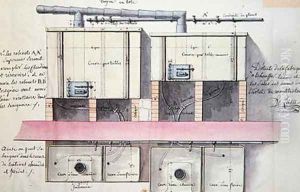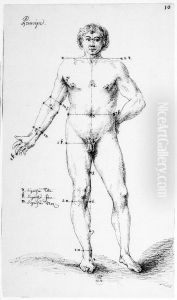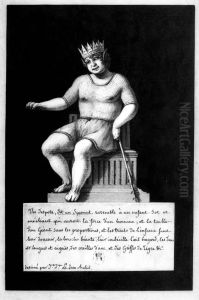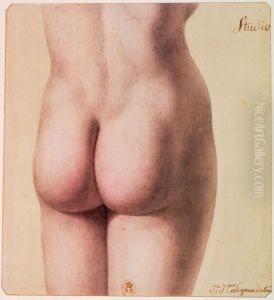Jean-Jacques Lequeu Paintings
Jean-Jacques Lequeu was a French draughtsman and architect born on September 14, 1757, in Rouen, France. He is recognized for his detailed architectural drawings and enigmatic personal works that combine architectural fantasies with eroticism. Living through the turbulent times of the French Revolution and the Napoleonic era, Lequeu's career and artistic output were significantly influenced by the social and political upheavals of his time.
Initially trained as a draftsman in Rouen, Lequeu moved to Paris to further his career. He studied architecture under the prominent architect Jacques-Germain Soufflot, who designed the Panthéon in Paris. Despite his education and skill, Lequeu struggled to establish a successful architectural career. He worked for a time in the civil service as a geographic engineer, which allowed him to hone his drafting skills.
Lequeu's architectural designs often remained on paper and were rarely executed. His drawings are characterized by their meticulous detail and fantastical elements. He produced designs for temples, gardens, and other structures that blend classical architectural principles with imaginative and often surreal embellishments.
In addition to his architectural fantasies, Lequeu's body of work includes a series of highly personal and eccentric drawings that explore themes of sexuality, desire, and the human body. These works were not widely known during his lifetime and were only discovered after his death, contributing to his posthumous reputation as an artist ahead of his time.
Towards the end of his life, Lequeu fell into obscurity and poverty. In a bid to preserve his life's work, he donated a large collection of his drawings to the French National Library. Jean-Jacques Lequeu died on March 28, 1826, in Paris. His legacy was largely forgotten until the 20th century when art historians began to reassess his contribution to architectural drawing and the proto-surrealist elements in his work. Today, Lequeu is regarded as a unique figure whose imaginative creations prefigured some of the explorations of modern art and architecture.



![Le grand baailleur[sic]](https://www.niceartgallery.com/imgs/4661372/s/jeanjacques-lequeu-le-grand-baailleursic-453e6eca.jpg)
